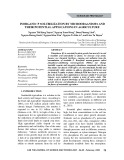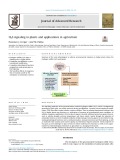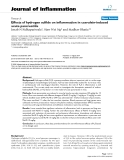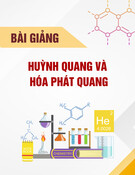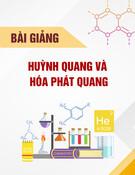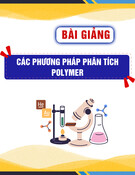Contents lists available at ScienceDirect
Journal of Advanced Research 24 (2020) 131–137
Journal of Advanced Research
j o u r n a l h o m e p a g e : w w w . e l s e v i e r . c o m / l o c a t e / j a r e
H2S signaling in plants and applications in agriculture
Francisco J. Corpas
⇑ , José M. Palma
h i g h l i g h t s
g r a p h i c a l a b s t r a c t
Summary of the main physiological or adverse environmental situations in higher plants where the hydrogen sulfide (H2S) participates.
(cid:1) Hydrogen sulfide (H2S) plays a signaling role in higher plants. (cid:1) It mediates persulfidation, a post-
translational modification.
(cid:1) It regulates physiological functions ranging from seed germination to fruit ripening.
(cid:1) The beneficial effects of exogenous
H2S are mainly caused by the stimulation of antioxidant systems.
a r t i c l e
i n f o
a b s t r a c t
Antioxidant, Free Radical and Nitric Oxide in Biotechnology, Food and Agriculture Group, Department of Biochemistry, Cell and Molecular Biology of Plants, Estación Experimental del Zaidín, Consejo Superior de Investigaciones Científicas (CSIC), C/ Profesor Albareda, 1, E-18008 Granada, Spain
Article history: Received 10 February 2020 Revised 24 March 2020 Accepted 25 March 2020 Available online 29 March 2020
The signaling properties of the gasotransmitter molecule hydrogen sulfide (H2S), which is endogenously generated in plant cells, are mainly observed during persulfidation, a protein post-translational modifi- cation (PTM) that affects redox-sensitive cysteine residues. There is growing experimental evidence that H2S in higher plants may function as a mechanism of response to environmental stress conditions. In addition, exogenous applications of H2S to plants appear to provide additional protection against stresses, such as salinity, drought, extreme temperatures and heavy metals, mainly through the induction of antioxidant systems, in order to palliate oxidative cellular damage. H2S also appears to be involved in reg- ulating physiological functions, such as seed germination, stomatal movement and fruit ripening, as well as molecules that maintain post-harvest quality and rhizobium–legume symbiosis. These properties of H2S open up new challenges in plant research to better understand its functions as well as new oppor- tunities for biotechnological treatments in agriculture in a changing environment. (cid:1) 2020 THE AUTHORS. Published by Elsevier BV on behalf of Cairo University. This is an open access article under the CC BY-NC-ND license (http://creativecommons.org/licenses/by-nc-nd/4.0/).
Introduction
Keywords: Hydrogen sulfide Abiotic stress Fruit ripening Nitro-oxidative stress
The description of the gasotransmitter hydrogen sulfide (H2S), with its toxic impact on the metabolism of animal and plant cells,
Peer review under responsibility of Cairo University. ⇑ Corresponding author. E-mail address: javier.corpas@eez.csic.es (F.J. Corpas).
https://doi.org/10.1016/j.jare.2020.03.011 2090-1232/(cid:1) 2020 THE AUTHORS. Published by Elsevier BV on behalf of Cairo University. This is an open access article under the CC BY-NC-ND license (http://creativecommons.org/licenses/by-nc-nd/4.0/).
changed drastically when this molecule was shown to be endoge- nously generated in cells. However, its signaling capacity has particularly fascinated researchers in many fields of investigation [1–5]. A number of studies in the field of plants began to show that H2S is directly or indirectly involved in a wide range of physiolog- ical processes including seed germination [6], root organogenesis [7,8], photosynthesis [9], stomatal movement [10–13], fruit ripen- ing [14,15], as well as senescence in leaves, flowers and fruits [16,17]. H2S has also been shown to be involved in the mechanism of response to adverse biotic and abiotic environmental conditions [18,19]. Research has shown a significant correlation between the functions of H2S and nitric oxide (NO), another simple molecule, whose metabolisms appear regulate each other [4]. Fig. 1 summa- rizes the principal functions of H2S in higher plants. The main aim of this review is to provide a broad overview of the major role played by H2S in higher plants, with particular attention paid to the beneficial effects of its biotechnological application in crop plants, especially under adverse stressful conditions.
132 F.J. Corpas, J.M. Palma / Journal of Advanced Research 24 (2020) 131–137
Plant biochemistry of H2S: An overview
specific plant protein using different H2S donors [15,34,35]. Table 1 shows a list of plant proteins, which have been observed to undergo persulfidation, and how their protein function is modu- lated [36,37]. In some cases, a specific purified protein can behave differently under in vitro conditions depending on whether the H2S donor is applied to the whole plant, added to the nutrient solution or growth media or sprayed on the aerial part of the plant. This is due to the complex action of H2S characterized by its functional interaction/competition in whole cells with other molecules including nitric oxide (NO) [4], melatonin [38] and phytohormones such as ethylene, auxin and abscisic acid [39,40].
The study of H2S as a signaling molecule has focused on its capacity to interact with thiol (-SH) groups present in protein cys- teine residues through the post-translational modification (PTM) persulfidation [4,20]. It is important to point out the major regula- tory role played by protein thiol groups involved in multiple inter- actions which can activate or inhibit the function of the target proteins [21,22]. H2S competes with other molecules, such as nitric oxide (NO), glutathione (GSH), cyanide and fatty acids, which gen- erate the PTMs S-nitrosation [4,23], S-glutathionylation [24,25], S-cyanylation [26] and S-acylation [27–29], respectively. Fig. 2 shows a simple model of these PTMs involving protein thiol groups. However, fewer studies have explored the potential protein targets of persulfidation, previously known as S-sulfhydration, and how this PTM affects up-regulates and down-regulates these proteins.
Information garnered from initial plant proteomic analyses focusing on the model plant Arabidopsis thaliana [30,31] and that obtained from animal cells [32,33], as well as complementary stud- ies, have facilitated the evaluation of the in vitro effect of H2S on a
Although the precise mechanisms involved remain unknown, H2S has been shown to regulate gene expression [41,42]. Exoge- nous applications of H2S to grapevine (Vitis vinifera L.) plants trig- ger gene expression involved in the synthesis of secondary metabolites as well as various defensive compounds which boosts plant development and abiotic resistance [43]. In addition, microarray analysis of differentially expressed genes of tomato plants supplemented with NaHS has shown that 5349 genes were up-regulated, while 5536 were down-regulated [44].
However, any precise biochemistry of endogenous H2S in plant cells, as well as how and where H2S is produced and its metabolic interactions with other molecules, is still in its infancy. In higher plant systems, several enzymes involved in cysteine metabolism present in subcellular compartments (the cytosol, chloroplasts, mitochondria and peroxisomes) are available for the production of H2S [35,45,46]. These enzymes include L-cysteine desulfhydrase (L-DES), L-cysteine desulfhydrase 1 (DES1), previously known as Cys synthase-like (CS-LIKE), and cysteine synthase (CS) in the cyto- sol; D-cysteine desulfhydrase (D-DES) and cyano alanine synthase (CAS) in mitochondria; and sulfite reductase (SiR) in the chloro- plast [3,46–48]. However, given its highly lipophilic nature, the H2S molecule can spread with ease throughout the lipid bilayer of cell membranes [49]. New promising data also show how activ- ities, such as cysteine desulfhydrases, in some of these enzymes are up-regulated under red light and down-regulated by blue and white light [50].
Potential biotechnological applications of exogenously applied H2S
Fig. 2. Protein thiol (-SH) modifications mediated by either the incorporation of H2S (persulfidation), NO (S-nitrosation), glutathione (GSH) (S-glutathionylation), cya- nide (S-cyanylation) or fatty acid (S-acylation).
Although further basic research on H2S is required, sufficient experimental data show that the exogenous application of H2S to different plant species at different stages of development can
Fig. 1. Summary of the main physiological or adverse environmental situations in higher plants where the endogenous or exogenous H2S seems to participate which could also have biotechnological applications.
133 F.J. Corpas, J.M. Palma / Journal of Advanced Research 24 (2020) 131–137
Table 1 Examples of plant protein targets which function is affected by H2S and consequently they undergo persulfidation. Enzyme Function Effect Ref.
RuBISCO O-acetylserine(thiol)lyase (OAS-TL) L-cysteine desulphydrase (LCD) Ascorbate peroxidase (APX) Glyceraldehyde 3-phosphate dehydrogenase Photosynthesis Sulfur metabolism Sulfur metabolism Antioxidant Energy production in the glycolysis Activity up-regulated Activity up-regulated Activity up-regulated Activity up-regulated Activity up-regulated [9] [9] [9] [30] [30] (GAPDH)
Glutamine synthetase (GS) Actin Activity down-regulated Inhibite actin polymerization [30] [36]
Metabolism of nitrogen Involved in organelle movement, in cell division and expansion Ethylene biosynthesis Activity down-regulated 1-aminocyclopropane-1-carboxylic acid oxidase [37] (ACO)
NADP-isocitrate dehydrogenase (NADP-ICDH) NADP-malic enzyme (NADP-ME) Catalase SNF1-RELATED PROTEIN KINASE2.6 (SnRK2.6) Provides NADPH as a reducing agent Provides NADPH as a reducing agent Antioxidant Promote ABA signaling. [15] [34] [35] [12]
responses, in most cases, the application of exogenous H2S appears to cause an increase in the different components of antioxidant systems, such as catalase, superoxide dismutase (SOD) isozymes, as well as enzymatic and non-enzymatic components of the ascorbate-glutathione cycle, which enables H2O2 levels and lipid peroxidation content to be reduced.
H2S in fruit ripening and post-harvest damage to fresh produce
vegetables
diverse
range
of
a
palliate damage caused by abiotic stress and enhance physiological features such as seed germination, root development and post- harvest preservation of vegetables [4,51,52]. However, an empiri- cal evaluation of how H2S is to be applied and appropriate dosages is also required. Up to now, exogenous applications have been car- ried out using chemicals capable of delivering H2S. In animal research on biomedical applications, different families of chemi- cals, with the capacity to slowly release H2S into cells, have been developed. This has led to the development of water-soluble mole- cules such as (p-methoxyphenyl)morpholino-phosphinodithioic acid (GYY4137) and a family of cysteine-activated H2S donors (5a, 8l, and 8o) [53]. Few plant studies have used these chemicals [54] which are comparatively more expensive to produce than standard chemicals such as sodium hydrosulfide (NaHS) and inor- ganic sodium polysulfides (Na2Sn) such as Na2S2, Na2S3, and Na2S4. Thus, in aqueous solutions, delivery of H2S by these polysulfides depends on medium pH and the corresponding pKa [55]. In plant research, the cheaper NaHS is exogenously added to hydroponic solutions and in vitro growth media or is sprayed directly on plants. NaHS, which is a short-lived donor and does not mimic the slow continuous process of H2S generation in vivo, is used in a wide range of concentrations. The chemical dialkyldithiophosphate, which is capable of slowly releasing H2S [56], has recently been demonstrated to increase corn plant weight by up to 39% after 4.5 weeks of treatment. Other compounds, which are capable of releasing NO combined with H2S, are being used in anti- inflammatory pharmaceutical treatments [57].
Information available on endogenous H2S metabolism in fruits and vegetables is highly limited. Recently, endogenous H2S content in non-climacteric sweet pepper (Capsicum annumm L) fruits was reported to increase during the transition from green immature to red ripe [15]. However, the number of studies focusing on the economic impact of biotechnological applications of H2S on fruit ripening and post-harvest storage, which prevent the loss of fresh produce caused by fungi, bacteria, viruses and low temperatures used to store fruits and vegetables, has increased over the last ten years. Given that all these factors are usually associated with oxidative stress, many studies have shown that the exogenous application of H2S could have a beneficial effect on the shelf life of and flowers fruits, [14,16,38,85,86]. Table 3 provides representative examples of the exogenous application of H2S to fruits and vegetables [87–94] which enables their quality to be maintained. Another common effect observed following exogenous treatment with H2S is an increase in antioxidant systems which prevent ROS overproduction and consequently oxidative damage.
H2S and abiotic stress
Implication of H2S in rhizobium–legume symbiosis
Many adverse external conditions are well known to negatively affect plant growth, development and productivity [58]. To palliate these effects, plants have developed various strategies which differ according to the type of stress and plant species involved. In many cases, these stresses are associated with unregulated overproduc- tion of reactivate oxygen and nitrogen species (ROS/RNS) which can trigger nitro-oxidative stress [59] characterized by an increase in key parameters such as lipid peroxidation, protein tyrosine nitration and oxidative damage to proteins and nucleic acids. Table 2 shows different examples of the beneficial effects of the exogenous application of H2S through the use of different donors on a wide range of agronomically important plants affected by stresses such as heavy metals (cadmium, aluminum, chromium, copper, iron, zinc), metalloids (arsenic), salinity, drought, as well as high and low temperatures [60–84]. Apart from certain specific
In agriculture and natural ecosystems, a major source of nitrogen-fixation is throughout the nodule formation during the plant-rhizobia interaction [95]. As happened with the NO that was seen to be involved in the interaction rhizobium–legume sym- biosis [96–98], H2S seems to be also involved in different ways in this process. A recent report indicates that exogenous H2S pro- motes plant growth, nodulation and nitrogenase activity in the functional symbiosis between rhizobium (Sinorhizobium fredii) and soybean (Glycine max) plants [99]. Furthermore, the synergy between H2S and rhizobia allowed the increase of soybean nitro- gen contents by the regulation of related enzymes at different (activity, protein, and gene expression) as well as levels senescence-associated genes which were also regulated [100]. Moreover, new data obtained during the Mesorhizobium–Lotus
Respiratory burst oxidase homolog protein D Generation of superoxide radical Activity down-regulated Activity down-regulated Activity down-regulated Promote ABA-induced stomatal closure Activity up-regulated [13] (RBOHD)
134 F.J. Corpas, J.M. Palma / Journal of Advanced Research 24 (2020) 131–137
Table 2 Main effects of the exogenous application of H2S to plants exposed to diverse environmental stresses. ABA, abscisic acid. APX, ascorbate peroxidase. AsA, ascorbate. CAT, catalase. GR, glutathione reductase. GSH, reduced glutathione. GSNOR, S-nitrosoglutathione reductase. HT, high temperature. MDA, malondialdehyde. POD, peroxidase. NaHS, sodium hydrosulfide. PIP, plasma membrane intrinsic proteins. PM, plama membrane. SOD, superoxide dismutase. Plant species Effects Ref. H2S donor(lM) Environmental stress [60] Aluminum NaHS(2) Rice (Oryza sativa L.)
NaHS(50) Soybean (Glycine max L.) [61]
[62] Cadmium (Cd) NaHS(100) Alfafa (Medicago sativa L.)
NaHS(500) Increases root elongation and decrease Al contents in rice root tips. Increase antioxidant enzyme activities. Decrease MDA and H2O2 content in roots Reduce Al accumulation. H2S function downstream of NO and induce citrate secretion through the upregulation of PM H+-ATPase-coupled citrate transporter cotransport systems Reduces the accumulation of MDA and H2O2. Increase the content of GSH and the activity of antioxidant enzymes (SOD, CAT and POD) Alleviates Cd damages by modulating enzymatic and non-enzymatic antioxidants. [63]
[64] NaHS(200) Reduces the accumulation of H2O2 and superoxide ions in roots
Increases the activities of antioxidant enzymes. Inhibits Cd uptake and reduce proline content Overexpression of D-Cysteine desulfhydrase (DCD) decreases Cd and ROS content [65] [66]
Chromium(Cr) [67] [68] NaHS(200) Endogenous H2S NaHS(500) NaHS(200)
[6] Copper (Cu) NaHS(1,400)
[69] Iron deficiency NaHS(200)
Zinc (Zn) NaHS (200) [70]
Arsenic (As) Salinity NaHS(100) NaHS(50) NaHS(50) Alleviate chromium toxicity and enhances antioxidant activities (CAT, SOD, APX) Decreases Cr content, H2O2 and MDA concentrations. Increases activity of antioxidant enzymes Lowers levels of MDA and H2O2 in germinating seeds. Increases SOD and CAT activities, and decreases lipoxygenase Reduces electrolyte leakage, and content of H2O2 and MDA. Upregulate activities of antioxidant enzymes. Improved Fe uptake Increases plant growth, fruit yield, water status and proline content. Enhances the activity of antioxidant enzymes Increases of AsA and GSH contents and activities of the AsA–GSH cycle enzymes Decreases the uptake of Na+ and the Na+/K+ ratio Suppresses ROS accumulation by increasing antioxidant defense [71] [72] [73]
[74] NaHS(20) Bermudagrass (Cynodon dactylon L) Barley (Hordeum vulgare L.) Wheat (Triticum aestivum) Arabidopsis (Arabidopsis thaliana) Maize (Zea mays L.) Caulifower (Brassica oleracea L.) Wheat (Triticum aestivum L.) Strawberry (Fragaria (cid:3) ananassa) Pepper (Capsicum annuum L.) Pea (Pisum sativum L. Rice (Oryza sativa L.) Wheat (Triticum aestivum L.) Cucumber (Cucumis sativus L.)
NaHS(200) Keeps Na+ and K+ homeostasis by the gene expression of plasma membrane Na+/ H + antiporter (SOS1). Decrease lipid peroxidation content and ROS generation. Increases activity of antioxidant system Enhances the quantum efficiency of photosystem II (PSII) and the membrane lipid stability [75]
Drought NaHS(500) [40]
NaHS(400) Increases antioxidant enzyme activities, reduces MDA and H2O2 contents in both leaves and roots. Increases of the transcription levels of genes encoding ABA receptors. Induction of genes that code for antioxidant enzymes [76]
Mangrove plant (Kandelia obovata) Wheat (Triticum aestivum L.) Wheat (Triticum aestivum L.) Alfalfa (Medicago sativa L.) Lowers MDA. Induce Cu/ZnSOD, FeSOD genes [77]
NOSH(1) compounds (100) NaHS(150) Osmotic stress [78]
Low NaHS(50) Increase phospholipase Da1 and the antioxidant enzyme system. Reduce ROS and MDA content and reduce electrolyte leakage Increases GSH and cucurbitacin C content [79] temperature NaHS(500) [80]
[81] High NaHS(100) Alleviate the degradation of chlorophyll and carotenoids and reduce the photoinhibition of PSII and PSI. Induction of gene expression ocoding for antioxidant enzymes (cAPX, CAT, MnSOD, GR), heat shock proteins (HSP70, HSP80, HSP90) and aquaporins (PIP) temperature
Improves seed germination and increases antioxidant enzymes. Accumulation of proline Increases GSNOR activity and reduce HT-induced damage to the photosynthetic system [82] [83]
1 Resulted in the Utility Patent Pub. No.: WO/2015/123273.
symbiosis indicate that this interaction is regulated by the cross- talk among H2S with other signaling molecules including NO and ROS [101].
Conclusions and future perspectives
H2S, which is part of the plant sulfur metabolism, is a new signal molecule whose regulatory function acts through redox interac- tions, especially the protein post-translational modification persul- fidation. The application of exogenous H2S, involving a signaling mechanism, causes an increase in different components of the antioxidant system at both the gene and protein level. Nevertheless,
the precise biochemical and molecular mechanisms involved in these processes need to be further investigated in future research. However, the exogenous application of H2S undoubtedly has a beneficial effect on different plant species, especially those of considerable agronomic interest under adverse environmental conditions. Therefore, the use of H2S alone or combined with other molecules, such as nitric oxide, melatonin, thiourea, silicon, chi- tosan and calcium, which appear to beneficially affect crop plants, needs to be explored in light of climate change [102–108]. Thus, additional research is necessary in order to decipher the unknowns of H2S and its interaction with the metabolism of ROS and RNS under physiological and stressful conditions [109], as well as to establish biotechnological strategies to combat these stresses,
Arabidopsis (Arabidopsis thaliana) Cucumber (Cucumis sativus L.) Lowbush blueberry (Vaccinium angustifolium) Strawberry (Fragaria (cid:3) ananassa cv. ’Camarosa’) Maize (Zea mays L.) Poplar (Populus trichocarpa) Arabidopsis thaliana [84] NaHS(500) NaHS (50) or MGYY4137 (10) NaHS (100) or GYY4137 (10) Enhances seed germination rate under HT.Increases gene expression of ABI5 (ABA- INSENSITIVE 5).
135 F.J. Corpas, J.M. Palma / Journal of Advanced Research 24 (2020) 131–137
Table 3 Representative examples of the main beneficial effects of the exogenous application of H2S in fruits and vegetables. Fruit/vegetable Effects Ref. H2S donor
Strawberry (Fragaria (cid:3) ananassa Duch.) Broccoli (Brassica oleracea) Grape (Vitis vinifera L. (cid:3) V. labrusca L. cv. 0.8 mM NaHS 2.4 mM NaHS 1 mM NaHS Prolongs postharvest shelf life and reduces fruit rot disease Alleviates senescent symptoms Alleviates postharvest senescence of grape and maintain high fruit quality [87] [88] [89] Kyoho)
Banana (Musa acuminata, AAA group) Tomato (Solanum lycopersicum L.) ‘Micro Tom’ 1 mM NaHS 0.9 mM NaHS [14] [90]
Hawthorn (Crataegus oxyacantha) fruit 1.5 mM NaHS [91]
[92] [42] Avocado (Persea americana Mill, cv. ’Hass’) Kiwifruit (Actinidia chinensis) 200 mMNaHS 20 mM H2S
Daylily (Hemerocallis fulva) 4 mMNaHS [93]
Tomato (Solanum lycopersicum L.). 1 M NaHS Alleviates fruit softening. Antagonizes ethylene effects Postpones ripening and senescence of postharvest tomato fruits by antagonizing the effects of ethylene Confers tolerance to chilling. Triggers H2S accumulation, increase antioxidant enzyme activities of and promote phenolics accumulation Protects against frost and day high light Delays ripening and senescence. Inhibits ethylene production. Increases antioxidant activities. Regulates the cell wall degrading enzyme gene Delays senescence of postharvest daylily flowers. Increases antioxidant capacity to maintain the redox balance Inhibits ethylene-induced petiole abscission [94]
which are responsible for major losses in plant yield and crop productivity.
Compliance with Ethics requirements
heme oxygenase-modulated stomatal closure. Plant Cell Environ 2019. doi: https://doi.org/10.1111/pce.13685.
This article does not contain any studies with human or animal
subjects.
[12] Chen S, Jia H, Wang X, Shi C, Wang X, Ma P, et al. Hydrogen sulfide positively regulates abscisic acid signaling through persulfidation of SnRK2.6 in guard cells. Mol Plant. 2020;S1674–2052(20):30004–6. doi: https://doi.org/ 10.1016/j.molp.2020.01.004.
Declaration of Competing Interest
[13] Shen J, Zhang J, Zhou M, Zhou H, Cui B, Gotor C, et al. Persulfidation-based modification of cysteine desulfhydrase and the NADPH oxidase RBOHD controls guard cell abscisic acid signaling. Plant Cell 2020. doi: https://doi. org/10.1105/tpc.19.00826.
The authors declare that they have no known competing financial interests or personal relationships that could have appeared to influ- ence the work reported in this paper.
[14] Ge Y, Hu KD, Wang SS, Hu LY, Chen XY, Li YH, et al. Hydrogen sulfide alleviates postharvest ripening and senescence of banana by antagonizing the effect of ethylene. PLoS One 2017;12(6):e0180113.
Acknowledgements
[15] Muñoz-Vargas MA, González-Gordo S, Cañas A, López-Jaramillo J, Palma JM, Corpas FJ. Endogenous hydrogen sulfide (H2S) is up-regulated during sweet pepper (Capsicum annuum L.) fruit ripening. In vitro analysis shows that NADP-dependent isocitrate dehydrogenase (ICDH) activity is inhibited by H2S and NO. Nitric Oxide 2018;81:36–45.
[16] Zhang H, Hu SL, Zhang ZJ, Hu LY, Jiang CX, Wei ZJ, et al. Hydrogen sulfide acts as a regulator of flower senescence in plants. Postharvest Biol Technol 2011;60:251–7.
[17] Zheng JL, Hu LY, Hu KD, Wu J, Yang F, Zhang H. Hydrogen sulfide alleviates senescence of fresh-cut apple by regulating antioxidant defense system and senescence-related gene expression. HortScience 2016;51:152–8.
FJC and JMP research is supported by a European Regional Development Fund cofinanced grant from the Spanish Ministry of Economy and Competitiveness (AGL2015-65104-P and PID2019- 103924GB-I00), the Plan Andaluz de Investigación, Desarrollo e Innovación (PAIDI 2020) (P18-FR-1359) and Junta de Andalucía (group BIO192), Spain.
[18] Shi H, Ye T, Han N, Bian H, Liu X, Chan Z. Hydrogen sulfide regulates abiotic stress tolerance and biotic stress resistance in Arabidopsis. J Integr Plant Biol 2015;57(7):628–40.
References
[19] Banerjee A, Tripathi DK, Roychoudhury A. Hydrogen sulphide trapeze: Environmental stress amelioration and phytohormone crosstalk. Plant Physiol Biochem 2018;132:46–53. [20] Aroca A, Gotor C, Romero LC. Hydrogen sulfide signaling in plants: emerging roles of protein persulfidation. Front Plant Sci 2018;9:1369.
[1] Abe K, Kimura H. The possible role of hydrogen sulfide as an endogenous neuromodulator. J Neurosci 1996;16:1066–71. [21] Duan J, Gaffrey MJ, Qian WJ. Quantitative proteomic characterization of redox-dependent post-translational modifications on protein cysteines. Mol BioSyst 2017;13(5):816–29. [22] Bhatnagar A, Bandyopadhyay D. Characterization of
[2] Lisjak M, Teklic T, Wilson ID, Whiteman M, Hancock JT. Hydrogen sulfide: environmental factor or signalling molecule?. Plant Cell Environ 2013;36 (9):1607–16. cysteine thiol modifications based on protein microenvironments and local secondary structures. Proteins. 2018;86(2):192–209. [3] Filipovic MR, Jovanovic VM. More than just an intermediate: hydrogen sulfide signalling in plants. J Exp Bot 2017;2017(68):4733–6. [4] Corpas FJ, González-Gordo S, Cañas A, Palma JM. Nitric oxide and hydrogen [23] Astier J, Kulik A, Koen E, Besson-Bard A, Bourque S, Jeandroz S, et al. Protein S- nitrosylation: what’s going on in plants?. Free Radic Biol Med 2012;53 (5):1101–10. sulfide in plants: which comes first?. J Exp Bot 2019;70:4391–404. [5] Kimura H. Signaling by hydrogen sulfide (H2S) and polysulfides (H2Sn) in the central nervous system. Neurochem Int 2019;126:118–25. [24] Zaffagnini M, Bedhomme M, Marchand CH, Morisse S, Trost P, Lemaire SD. Redox regulation in photosynthetic organisms: focus on glutathionylation. Antioxid Redox Signal 2012;16(6):567–86.
[6] Zhang H, Hu LY, Hu KD, He YD, Wang SH, Luo JP. Hydrogen sulfide promotes wheat seed germination and alleviates oxidative damage against copper stress. J Integr Plant Biol 2008;50:1518–29.
[25] Diaz-Vivancos P, de Simone A, Kiddle G, Foyer CH. Glutathione-linking cell proliferation to oxidative stress. Free Radic Biol Med. 2015;89:1154–64. [26] García I, Arenas-Alfonseca L, Moreno I, Gotor C, Romero LC. HCN Regulates cellular processes through posttranslational modification of proteins by S- cyanylation. Plant Physiol 2019;179(1):107–23. [7] Zhang H, Tang J, Liu XP, Wang Y, Yu W, Peng WY, et al. Hydrogen sulfide promotes root organogenesis in Ipomoea batatas, Salix matsudana and Glycine max. J Integr Plant Biol 2009;51:1084–92. [27] Hemsley PA. An outlook on protein S-acylation in plants: what are the next steps?. J Exp Bot 2017;68(12):3155–64. [28] Li Y, Qi B. Progress toward understanding protein S-acylation: prospective in [8] Mei Y, Zhao Y, Jin X, Wang R, Xu N, Hu J, et al. L-Cysteine desulfhydrase- dependent hydrogen sulfide is required for methane-induced lateral root formation. Plant Mol Biol 2019;99(3):283–98. plants. Front Plant Sci 2017;8:346. [29] Zheng L, Liu P, Liu Q, Wang T, Dong J. Dynamic protein S-acylation in plants. through promoting Int J Mol Sci 2019;20(3):E560.
[9] Chen J, Wu FH, Wang WH, Zheng CJ, Lin GH, Dong XJ, et al. Hydrogen sulphide enhances photosynthesis chloroplast biogenesis, photosynthetic enzyme expression, and thiol redox modification in Spinacia oleracea seedlings. J Exp Bot 2011;62(13):4481–93. [10] García-Mata C, Lamattina L. Hydrogen sulphide, a novel gasotransmitter [30] Aroca Á, Serna A, Gotor C, Romero LC. S-sulfhydration: a cysteine posttranslational modification in plant systems. Plant Physiol 2015;168 (1):334–42. involved in guard cell signaling. New Phytol 2010;188:977–84.
[31] Aroca A, Benito JM, Gotor C, Romero LC. Persulfidation proteome reveals the regulation of protein function by hydrogen sulfide in diverse biological processes in Arabidopsis. J Exp Bot 2017;68(17):4915–27. [11] Zhang J, Zhou M, Ge Z, Shen J, Zhou C, Gotor C, et al. ABA-triggered guard cell L -cysteine desulfhydrase function and in situ H2S production contributes to
136 F.J. Corpas, J.M. Palma / Journal of Advanced Research 24 (2020) 131–137
[32] Mustafa AK, Gadalla MM, Sen N, Kim S, Mu W, Gazi SK, et al. H2S signals through protein S-sulfhydration. Sci Signal 2009;2:ra72.
[61] Wang H, Ji F, Zhang Y, Hou J, Liu W, Huang J, et al. Interactions between hydrogen sulphide and nitric oxide regulate two soybean citrate transporters during the alleviation of aluminium toxicity. Plant Cell Environ 2019;42 (8):2340–56. [33] Fu L, Liu K, He J, Tian C, Yu X, Yang J. Direct proteomic mapping of cysteine persulfidation. Antioxid Redox Signal 2019. doi: https://doi.org/10.1089/ ars.2019.7777.
[62] Li L, Wang Y, Shen W. Roles of hydrogen sulfide and nitric oxide in the alleviation of cadmium-induced oxidative damage in alfalfa seedling roots. Biometals 2012;25(3):617–31.
[63] Shi H, Ye T, Chan Z. Nitric oxide-activated hydrogen sulfide is essential for cadmium stress response in bermudagrass (Cynodon dactylon (L). Pers.). Plant Physiol Biochem 2014;74:99–107. [34] Muñoz-Vargas MA, González-Gordo S, Palma JM. Corpas FJ. Inhibition of NADP-malic enzyme activity by H2S and NO in sweet pepper (Capsicum annuum L.) fruits. Physiol Plant 2020;168(2):278–88. 10.1111/ppl.13000. [35] Corpas FJ, Barroso JB, González-Gordo S, Muñoz-Vargas MA, Palma JM. Hydrogen sulfide: a novel component in Arabidopsis peroxisomes which triggers catalase inhibition. J Integr Plant Biol 2019;61(7):871–83.
[64] Fu MM, Dawood M, Wang NH, Wu F. Exogenous hydrogen sulfide reduces cadmium uptake and alleviates cadmium toxicity in barley. Plant Growth Regul 2019;89:227–37. [36] Li J, Chen S, Wang X, Shi C, Liu H, Yang J, et al. Hydrogen sulfide disturbs actin polymerization via S-Sulfhydration resulting in stunted root hair growth. Plant Physiol 2018;178(2):936–49.
[37] Jia H, Chen S, Liu D, Liesche J, Shi C, Wang J, et al. Ethylene-induced hydrogen sulfide negatively regulates ethylene biosynthesis by persulfidation of ACO in tomato under osmotic stress. Front Plant Sci 2018;9:1517. [65] Kaya C, Ashraf M, Alyemeni MN, Ahmad P. Responses of nitric oxide and hydrogen sulfide in regulating oxidative defence system in wheat plants grown under cadmium stress. Physiol Plant 2020;168(2):345–60. doi: https://doi.org/10.1111/ppl.13012.
[66] Zhang Q, Cai W, Ji TT, Ye L, Lu YT, Yuan TT. WRKY13 enhances cadmium tolerance by promoting D-CYSTEINE DESULFHYDRASE and hydrogen sulfide production pp. 01504.2019. Plant Physiol 2020:01504. doi: https://doi.org/ 10.1104/pp.19.01504.
[38] Mukherjee S. Recent advancements in the mechanism of nitric oxide signaling associated with hydrogen sulfide and melatonin crosstalk during ethylene-induced fruit ripening in plants. Nitric Oxide 2019;82:25–34. [39] Jia H, Hu Y, Fan T, Li J. Hydrogen sulfide modulates actin-dependent auxin transport via regulating ABPs results in changing of root development in Arabidopsis. Sci Rep 2015;5:8251.
[67] Kharbech O, Houmani H, Chaoui A, Corpas FJ. Alleviation of Cr(VI)-induced oxidative stress in maize (Zea mays L.) seedlings by NO and H2S donors through differential organ-dependent regulation of ROS and NADPH- recycling metabolisms. J Plant Physiol 2017;219:71–80. [40] Ma D, Ding H, Wang C, Qin H, Han Q, Hou J, et al. Alleviation of drought stress by hydrogen sulfide is partially related to the abscisic acid signaling pathway in wheat. PLoS One 2016;11:e0163082.
[41] Pandey AK, Gautam A. Stress responsive gene regulation in relation to hydrogen sulfide in plants under abiotic stress. Physiol Plant 2020. doi: https://doi.org/10.1111/ppl.13064. [68] Ahmad R, Ali S, Rizwan M, Dawood M, Farid M, Hussain A, et al. Hydrogen sulfide alleviates chromium stress on cauliflower by restricting its uptake and enhancing antioxidative system. Physiol Plant 2020;168(2):289–300. doi: https://doi.org/10.1111/ppl.13001.
[69] Kaya C, Ashraf M. The mechanism of hydrogen sulfide mitigation of iron deficiency-induced chlorosis in strawberry (Fragaria (cid:3) ananassa) plants. Protoplasma 2019;256(2):371–82. [42] Lin X, Yang R, Dou Y, Zhang W, Du H, Zhu L, et al. Transcriptome analysis reveals delaying of the ripening and cell wall degradation of kiwifruit by hydrogen sulfide. J Sci Food Agric 2020. doi: https://doi.org/10.1002/ jsfa.10260. [.
[43] Ma Q, Yang J. Transcriptome profiling and identification of functional genes involved in H2S response in grapevine tissue cultured plantlets. Genes Genomics 2018;40(12):1287–300. [70] Kaya C, Ashraf M, Akram NA. Hydrogen sulfide regulates the levels of key metabolites and antioxidant defense system to counteract oxidative stress in pepper (Capsicum annuum L.) plants exposed to high zinc regime. Environ Sci Pollut Res Int 2018;25(13):12612–8.
tolerance stress [44] Guo Z, Liang Y, Yan J, Yang E, Li K, Xu H. Physiological response and transcription profiling analysis reveals the role of H2S in alleviating excess nitrate in tomato roots. Plant Physiol Biochem 2018;124:59–69. [71] Singh VP, Singh S, Kumar J, Prasad SM. Hydrogen sulfide alleviates toxic effects of arsenate in pea seedlings through up-regulation of the ascorbate- glutathione cycle: Possible involvement of nitric oxide. J Plant Physiol 2015;181:20–9.
[45] Gotor C, Laureano-Marín AM, Moreno I, Aroca A, García I, Romero LC. sulfide?. Amino Acids Signaling in the plant cytosol: cysteine or 2015;47:2155–64. [72] Mostofa MG, Saegusa D, Fujita M, Tran LS. Hydrogen sulfide regulates salt tolerance in rice by maintaining Na(+)/K(+) balance, mineral homeostasis and oxidative metabolism under excessive salt stress. Front Plant Sci 2015;6:1055.
[46] Hancock JT, Whiteman M. Hydrogen sulfide signaling: Interactions with nitric oxide and reactive oxygen species. Ann N Y Acad Sci 2016;1365:5–14. [47] Calderwood A, Kopriva S. Hydrogen sulfide in plants: From dissipation of excess sulfur to signaling molecule. Nitric Oxide 2014;41:72–8. [73] Deng YQ, Bao J, Yuan F, Liang X, Feng ZT, Wang BS. Exogenous hydrogen sulfide alleviates salt stress in wheat seedlings by decreasing Na+ content. Plant Growth Regul 2016;79:391–9.
[48] Liu D, Lu J, Li H, Wang J, Pei Y. Characterization of the O-acetylserine(thiol) lyase gene family in Solanum lycopersicum L.. Plant Mol Biol 2019;99(1– 2):123–34. [74] Jiang JL, Tian Y, Li L, Yu M, Hou RP, Ren XM. H2S alleviates salinity stress in cucumber by maintaining the Na+/K+ balance and regulating H2S metabolism and oxidative stress response. Front Plant Sci 2019;10:678. [49] Cuevasanta E, Möller MN, Alvarez B. Biological chemistry of hydrogen sulfide and persulfides. Arch Biochem Biophys 2017;617:9–25. [75] Liu YL, Shen ZJ, Simon M, Li H, Ma DN, Zhu XY, et al. Comparative proteomic analysis reveals the regulatory effects of H2S on salt tolerance of mangrove plant Kandelia obovata. Int J Mol Sci 2019;21(1):E118.
[50] Liu Z, Cao C, Li Y, Yang G, Pei Y. Light regulates hydrogen sulfide signalling during skoto- and photo-morphogenesis in foxtail millet. Funct Plant Biol 2019. doi: https://doi.org/10.1071/FP19079. [76] Li H, Li M, Wei X, Zhang X, Xue R, Zhao Y, et al. Transcriptome analysis of drought-responsive genes regulated by hydrogen sulfide in wheat (Triticum aestivum L.) leaves. Mol Genet Genomics 2017;292(5):1091–110.
[51] Huo J, Huang D, Zhang J, Fang H, Wang B, Wang C, et al. Hydrogen sulfide: a gaseous molecule in postharvest freshness. Front Plant Sci 2018;9:1172. [52] Deng Y, Wang C, Wang N, Wei L, Li W, Yao Y, et al. Roles of small-molecule compounds in plant adventitious root development. Biomolecules 2019;9 (9).;pii:E420. [77] Antoniou C, Xenofontos R, Chatzimichail G, Christou A, Kashfi K, Fotopoulos V. Exploring the potential of nitric oxide and hydrogen sulfide (NOSH)-releasing synthetic compounds as novel priming agents against drought stress in Medicago sativa plants. Biomolecules 2020;10(1):E120. [53] Zhao Y, Wang H, Xian M. Cysteine-activated hydrogen sulfide (H2S) donors. J Am Chem Soc 2011;133(1):15–7.
species (rss) [54] Yamasaki H, Ogura MP, Kingjoe KA, Cohen MF. D-Cysteine-induced rapid root abscission in the water fern Azolla pinnata: implications for the linkage between d-amino acid and reactive sulfur in plant environmental responses. Antioxidants (Basel) 2019;8(9):E411. [78] Zhao M, Liu Q, Zhang Y, Yang N, Wu G, Li Q, et al. Alleviation of osmotic stress by H2S is related to regulated PLDa1 and suppressed ROS in Arabidopsis thaliana. J Plant Res 2020. doi: https://doi.org/10.1007/s10265-020-01182-3. [79] Liu Z, Li Y, Cao C, Liang S, Ma Y, Liu X, et al. The role of H2S in low temperature-induced cucurbitacin C increases in cucumber. Plant Mol Biol 2019;99(6):535–44.
[55] Gun J, Modestov A, Kamyshny A, Ryzkov D, Gitis V, Goifman A, et al. Electrospray ionization mass spectrometric analysis of aqueous polysulfide solutions. Microchim Acta 2004;46:229. [56] Carter JM, Brown EM, [80] Tang X, An B, Cao D, Xu R, Wang S, Zhang Z, et al. Improving photosynthetic capacity, alleviating photosynthetic inhibition and oxidative stress under low temperature stress with exogenous hydrogen sulfide in blueberry seedlings. Front Plant Sci 2020;11:108.
thermotolerance strawberry systemic plants to Irish EE, Bowden NB. Characterization of dialkyldithiophosphates as slow hydrogen sulfide releasing chemicals and their effect on the growth of maize. J Agric Food Chem 2019. doi: https://doi. org/10.1021/acs.jafc.9b04398. [81] Christou A, Filippou P, Manganaris GA, Fotopoulos V. Sodium hydrosulfide through induces transcriptional regulation of heat shock proteins and aquaporin. BMC Plant Biol 2014;14:42.
[57] Kashfi K, Chattopadhyay M, Kodela R. NOSH-sulindac (AVT-18A) is a novel nitric oxide- and hydrogen sulfide-releasing hybrid that is gastrointestinal safe and has potent anti-inflammatory, analgesic, antipyretic, anti-platelet, and anti-cancer properties. Redox Biol 2015;6:287–96. [82] Zhou ZH, Wang Y, Ye XY, Li ZG. Signaling molecule hydrogen sulfide improves seed germination and seedling growth of maize (Zea mays L.) under high temperature by inducing antioxidant system and osmolyte biosynthesis. Front. Plant Sci 2018;9:1288.
increasing tolerance stress by to [58] Mantri N, Patade V, Penna S, Ford R, Pang E. Abiotic stress responses in plants: present and future. In: Abiotic stress responses in plants. New York: Springer; 2012. p. 1–19. [59] Corpas FJ, Barroso JB. Nitro-oxidative stress vs oxidative or nitrosative stress in higher plants. New Phytol 2013;199(3):633–5. [83] Cheng T, Shi J, Dong Y, Ma Y, Peng Y, Hu X, et al. Hydrogen sulfide enhances poplar S- high-temperature nitrosoglutathione reductase (GSNOR) activity and reducing reactive oxygen/nitrogen damage. Plant Growth Regul 2018;84:11–23.
[60] Zhu CQ, Zhang JH, Sun LM, Zhu LF, Abliz B, Hu WJ, et al. Hydrogen sulfide alleviates aluminum toxicity via decreasing apoplast and symplast al contents in rice. Front Plant Sci 2018;9:294. [84] Chen Z, Huang Y, Yang W, Chang G, Li P, Wei J, et al. The hydrogen sulfide signal enhances seed germination tolerance to high temperatures by retaining nuclear COP1 for HY5 degradation. Plant Sci 2019;285:34–43.
137 F.J. Corpas, J.M. Palma / Journal of Advanced Research 24 (2020) 131–137
[85] Fotopoulos V, Christou A, Antoniou C, Manganaris GA. Hydrogen sulphide: a for the regulation of growth and defence responses in versatile tool horticultural crops. J Hortic Sci Biotechnol 2015;90:227–34.
[86] Ziogas V, Molassiotis A, Fotopoulos V, Tanou G. Hydrogen sulfide: a potent tool in postharvest fruit biology and possible mechanism of action. Front Plant Sci 2018;9:1375. [103] Batista PF, Müller C, Merchant A, Fuentes D, de Oliveira Silva Filho R, da Silva FB, Costa AC. Biochemical and physiological impacts of zinc sulphate, potassium phosphite and hydrogen sulphide in mitigating stress conditions in soybean. Physiol Plant 2019. doi: https://doi.org/10.1111/ppl.13034. [104] Waqas MA, Kaya C, Riaz A, Farooq M, Nawaz I, Wilkes A, et al. Potential mechanisms of abiotic stress tolerance in crop plants induced by thiourea. Front Plant Sci 2019;10:1336.
[87] Hu LY, Hu SL, Wu J, Li YH, Zheng JL, Wei ZJ, et al. Hydrogen sulfide prolongs postharvest shelf life of strawberry and plays an antioxidative role in fruits. J Agric Food Chem 2012;60(35):8684–93. [105] Bianchini HC, Marques DJ. Tolerance to hydric stress on cultivars of silicon fertilized corn crops: absorption and water use efficiency. Biosci J 2019;35 (2):527–39.
[106] Hidangmayum A, Dwivedi P, Katiyar D, Hemantaranjan A. Application of chitosan on plant responses with special reference to abiotic stress. Physiol Mol Biol Plants 2019;25(2):313–26.
[88] Li SP, Hu KD, Hu LY, Li YH, Jiang AM, Xiao F, et al. Hydrogen sulfide alleviates postharvest senescence of broccoli by modulating antioxidant defense and senescence-related gene expression. J Agric Food Chem 2014;62(5):1119–29. [89] Ni ZJ, Hu KD, Song CB, Ma RH, Li ZR, Zheng JL, et al. Hydrogen sulfide alleviates postharvest senescence of grape by modulating the antioxidant defenses. Oxid Med Cell Longev 2016;2016:4715651. [107] Geng B, Huang D, Zhu S. Regulation of Hydrogen sulfide metabolism by nitric oxide inhibitors and the quality of peaches during cold storage. Antioxidants (Basel) 2019;8:401.
[90] Yao GF, Wei ZZ, Li TT, Tang J, Huang ZQ, Yang F, et al. Modulation of enhanced antioxidant activity by hydrogen sulfide antagonization of ethylene in tomato fruit ripening. J Agric Food Chem 2018;66(40):10380–7. [108] Valivand M, Amooaghaie R, Ahadi A. Seed priming with H2S and Ca2+ trigger signal memory that induces cross-adaptation against nickel stress in zucchini seedlings. Plant Physiol Biochem 2019;143:286–98. [109] Corpas FJ. Hydrogen Sulfide: a new warrior against abiotic stress. Trends Plant Sci 2019;24(11):983–8.
[91] Aghdam MS, Mahmoudi R, Razavi F, Rabiei V, Soleimani A. Hydrogen sulfide treatment confers chilling tolerance in hawthorn fruit during cold storage by triggering endogenous H2S accumulation, enhancing antioxidant enzymes activity and promoting phenols accumulation. Sci Hortic 2018;238:264–71. [92] Joshi NC, Yadav D, Ratner K, Kamara I, Aviv-Sharon E, Irihimovitch V, et al. Sodium hydrosulfide priming improves the response of photosynthesis to overnight frost and day high light in avocado (Persea americana Mill, cv. ‘Hass’). Physiol Plant 2020;168(2):394–405. doi: https://doi.org/10.1111/ ppl.13023.
[93] Liu D, Xu S, Hu H, Pan J, Li P, Shen W. Endogenous hydrogen sulfide homeostasis is responsible for the alleviation of senescence of postharvest daylily flower via increasing antioxidant capacity and maintained energy status. J Agric Food Chem 2017;65(4):718–26.
[94] Liu D, Li J, Li Z, Pei Y. Hydrogen sulfide inhibits ethylene-induced petiole abscission in tomato (Solanum lycopersicum L.). Hortic Res 2020;7:14. [95] Mahmud K, Makaju S, Ibrahim R, Missaoui A. Current progress in nitrogen fixing plants and microbiome research. Plants (Basel). 2020;9(1):97.
[96] Puppo A, Pauly N, Boscari A, Mandon K, Brouquisse R. Hydrogen peroxide and nitric oxide: key regulators of the Legume-Rhizobium and mycorrhizal symbioses. Antioxid Redox Signal 2013;18:2202–19. Francisco J. Corpas is Research Professor of the Spanish National Research Council (CSIC) which has more than 28 years of research experience in the metabolism of Reactive Oxygen, Nitrogen and Sulfur Species (ROS, RNS and RSS, respectively) in higher plants under physiology and environmental stress conditions. Special interests are the implications of these reactive species in fruit ripening and the nitro-oxidative metabolism of plant peroxisome. He was the Head of the Department of Biochemistry, Cell and Molecular Biology of Plants (2014–2018) at Research Institute named ‘‘Estación Experimental del Zaidín”-CSIC, Granada Spain. He already published more than 203 refereed research papers/review articles in peer reviewed journals (according with Scopus database with h-index: 58) and edited seven books. [97] Hichri I, Boscari A, Castella C, Rovere M, Puppo A, Brouquisse R. Nitric oxide: a multifaceted regulator of the nitrogen-fixing symbiosis. J Exp Bot 2015;66 (10):2877–87.
[98] Berger A, Guinand S, Boscari A, Puppo A, Brouquisse R. Medicago truncatula phytoglobin 1.1 controls symbiotic nodulation and nitrogen fixation via the regulation of nitric oxide concentration. New Phytol 2020. doi: https://doi. org/10.1111/nph.16462.
[99] Zou H, Zhang NN, Pan Q, Zhang JH, Chen J, Wei GH. Hydrogen sulfide promotes nodulation and nitrogen fixation in soybean-rhizobia symbiotic system. Mol Plant Microbe Interact 2019;32(8):972–85.
[100] Zhang NN, Zou H, Lin XY, Pan Q, Zhang WQ, Zhang JH, et al. Hydrogen sulfide and rhizobia synergistically regulate nitrogen (N) assimilation and remobilization during N deficiency-induced senescence in soybean. Plant, Cell Environ 2020. doi: https://doi.org/10.1111/pce.13736.
[101] Fukudome M, Shimada H, Uchi N, Osuki KI, Ishizaki H, Murakami EI, et al. Reactive sulfur species interact with other signal molecules in root nodule symbiosis in Lotus japonicus. Antioxidants (Basel) 2020;9(2):145. José Manuel Palma is Research Professor with expertise on antioxidants and free radicals in plant systems. With more than 120 peer-reviewed research papers pub- lished, he has also been editor of five books and several special issues of diverse international journals. At pre- sent, he is involved in the investigation of the interac- tion between nitric oxide and antioxidants during fruit ripening. He leads the research group ‘‘Antioxidants, Free Radicals and Nitric Oxide in Biotechnology, Food and Agriculture” at Estación Experimental del Zaidín (EEZ), CSIC, Granada, Spain. He was also Deputy Director and Acting Director of the EEZ (CSIC) in the period 2007–2014.
[102] Fuentes-Lara LO, Medrano-Macías J, Pérez-Labrada F, Rivas-Martínez EN, García-Enciso EL, González-Morales S, et al. From elemental sulfur to hydrogen sulfide in agricultural soils and plants. Molecules 2019;24(12): E2282.

